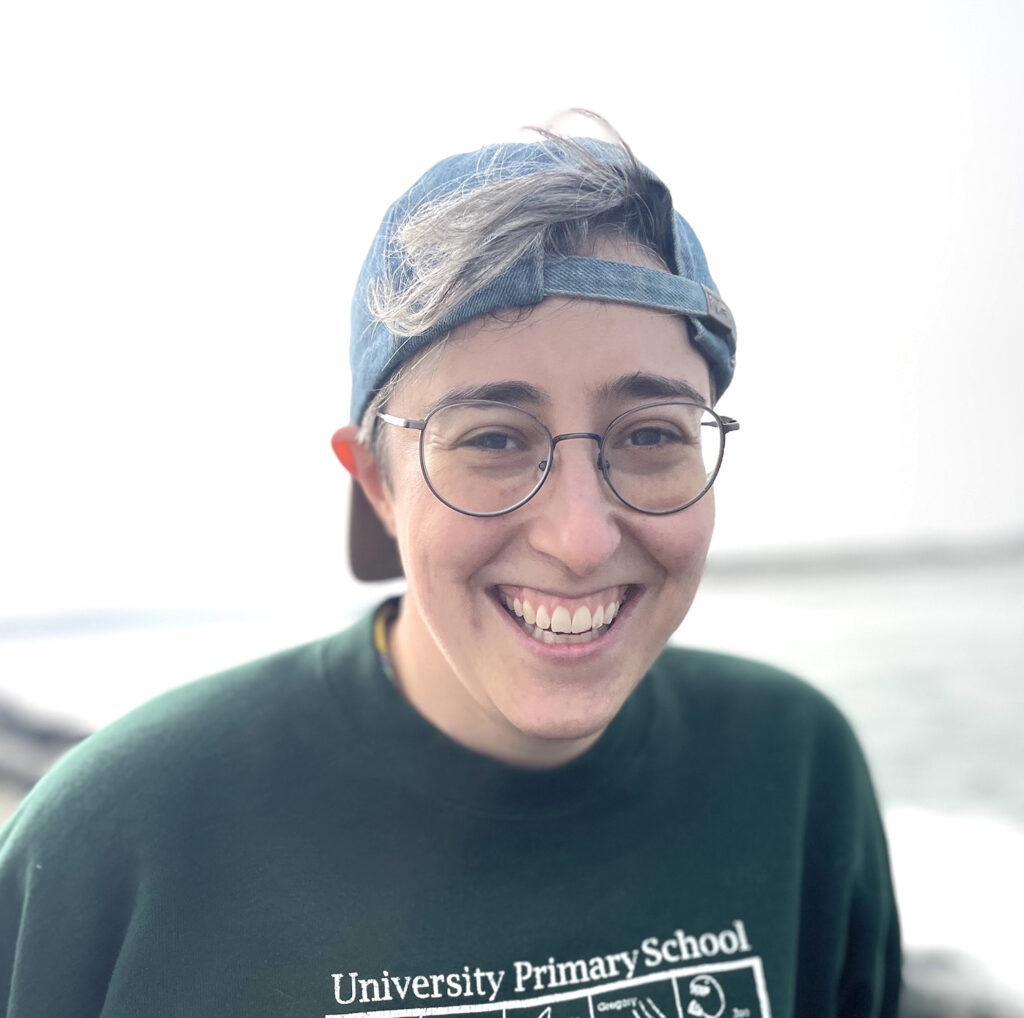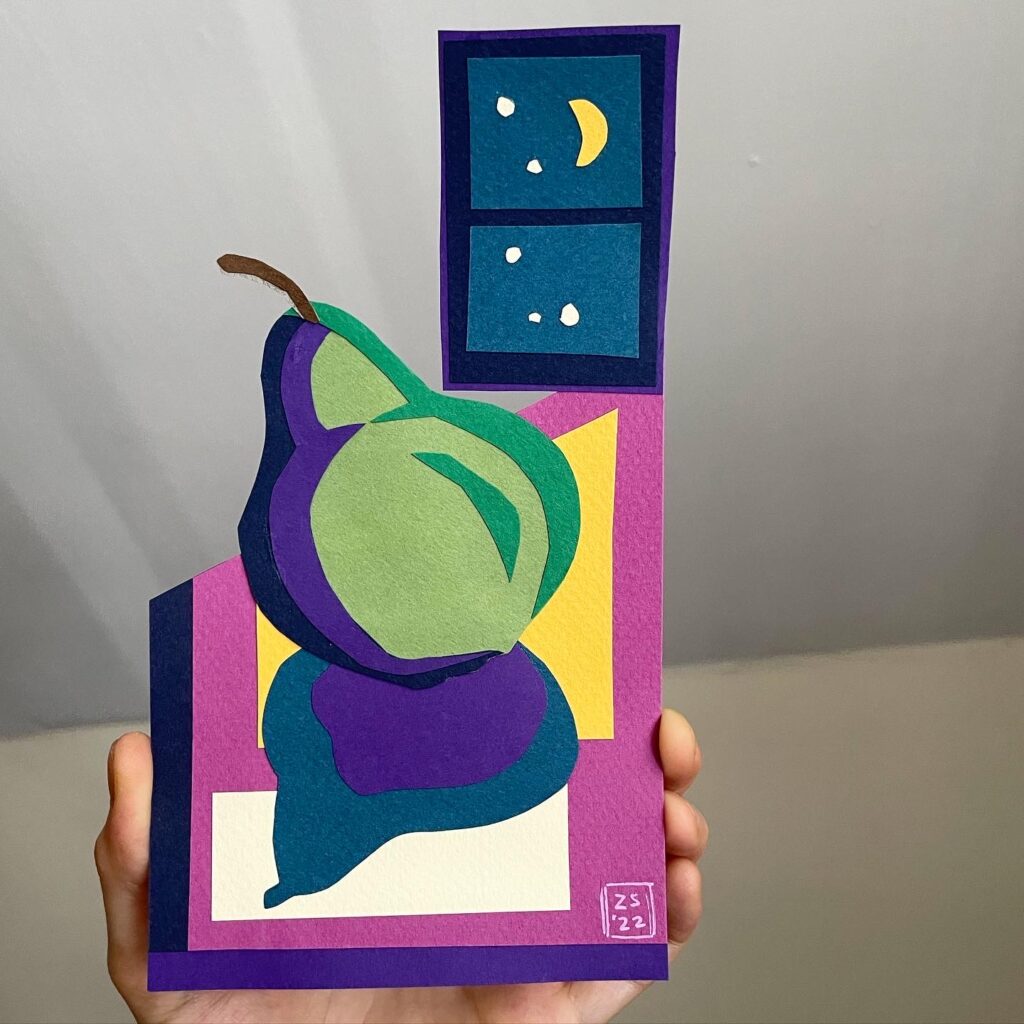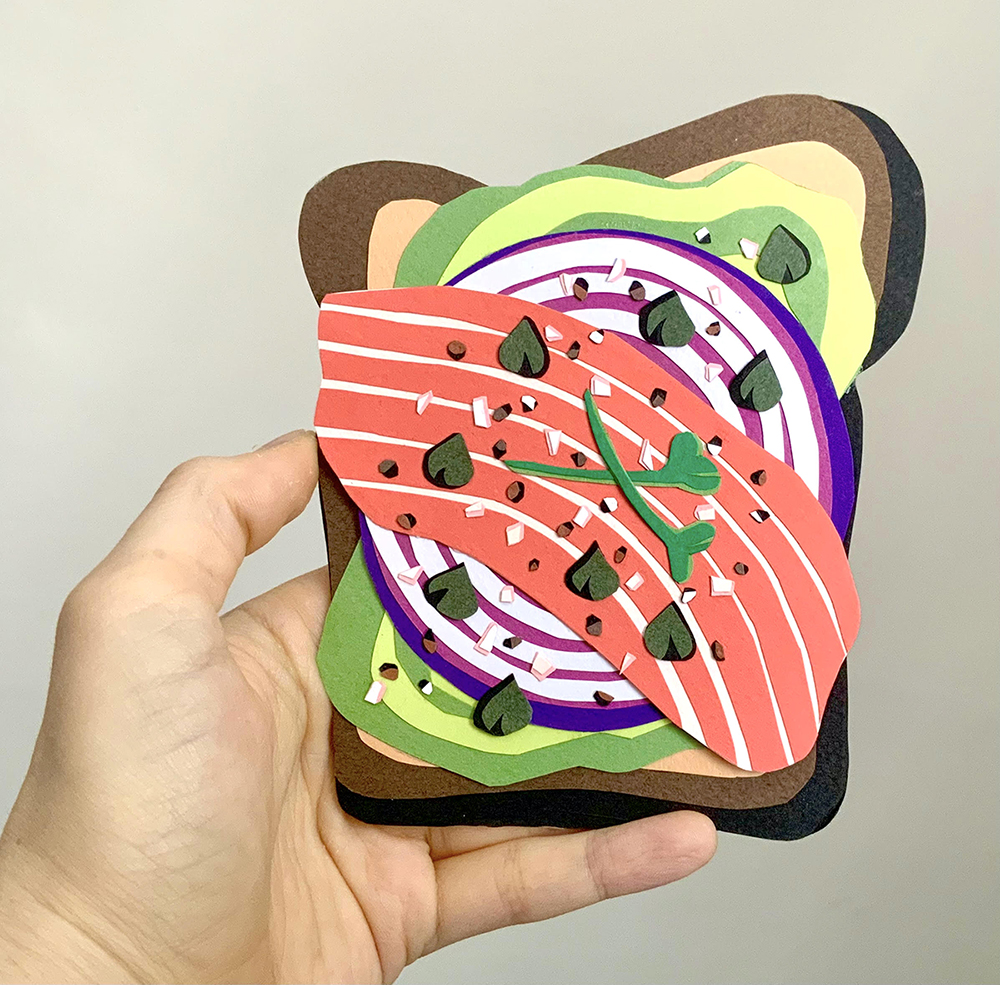Zoe Schein is one of 12 artists selected as a Gallery 263 2023–2024 Small Works Project artist. This project presents artwork in flat files at the gallery and on our website. Visit Schein’s Small Works Project page →
Can you tell us a little about yourself?

I’m an artist, illustrator, and teacher – three distinct but very related jobs. I grew up in Illinois and I have a strong attachment to the Midwest, which comes up in my art quite a bit. In many ways, I came to visual art by way of writing: I studied creative nonfiction for a number of years before my focus shifted toward visual art, and I still lead an inter-generational memoir writing group. I’m a big reader, and my reading life often inspires my work, especially poetry.
As an illustrator, my recent work has been on educational comics and graphic novels. I illustrated a book of graphic short stories for medical education called Clinical Ethics: A Graphic Medicine Casebook, and another (publication forthcoming) called Love Is Learned: A Choose-Your-Own Relationship Adventure, which is aimed at middle- and high school aged students. Comics are a fantastic educational tool – not only are they visually appealing and more fun to read than a regular textbook, but also because image affords us a different kind of thinking and analysis than the written word.
When I’m teaching my own classes, I specialize broadly in comics and drawing. My students range from ages 8 to 85, and working with both kids and adults is one of my favorite parts of my job. There’s no better way to learn than to teach, and I delight in the endless diversity of thinking that my students bring to art and artmaking. There are so many ways to engage with art: intellectually, spiritually, emotionally, intuitively, playfully… and I love helping students figure out how creativity can find a meaningful place in their lives.
What kind of art do you make?

For the past two years, my personal artwork has been almost exclusively cut paper compositions. For a long time I’ve been trying to pull the disparate threads of my “illustration” and “fine art” work together, to find a visual language informed by both sides of my background. To that end, I also work a lot in pen and ink—a medium that is just as comfortable in a comic as on a gallery wall.
What concepts does your art explore?
On the purely aesthetic side, my work aims to grow exuberant images under restrictive conditions. Most often I work with limited color palettes – not by my own restriction, but the materials’. I choose media that are limited to a set number of colors, like the Canson colored art papers, or Posca art markers, or colored pens – materials that can be layered or juxtaposed, but not really mixed or blended.
Cut paper also limits me to crisp, hard lines and edges; I can’t fade between values, and there are no smooth gradients available in the medium as I’ve defined it for myself. I usually limit myself to working with scissors rather than art knives, which forces me to keep shapes and details simple and protects me from my own tendency to get lost in minutiae. Not belaboring the fine details is also a kindness to my chronic back pain – so I work within the restrictions my body imposes as well.
Emotionally, I usually feel a piece is finished and successful when it achieves in me a sense of charged, buzzing stillness. I aim for an excited calm; an (admittedly oxymoronic) combination that reflects my relationship to my art practice itself, rich as it is in both (and ideally, occasionally, both at once). This integration of exuberance and placidity is an aspirational state, and I’m drawn to subject matter that evokes in me simultaneous thrill and contentment: nature, anatomy, food, art history, literature, teaching, and children’s art, to name a few.
Can you tell us about the work you have on view in your flat file drawer at the gallery?



The work in the Small Works Project drawer tells the story of my discovering and falling in love with the language of the cut-paper medium. I’ve only been working in cut paper for a couple years, and those years are well-represented by the pieces in the drawer. In these works, I’m really playing with and exploring the boundaries and possibilities of that new language. What can I do with paper that I can’t do with ink or pencil or paint? What can’t I do in this medium, and what boundaries and opportunities does that bring to the work?
Up until now, I feel that I’ve been learning to create a visual language within this medium and the guidelines I’ve set for myself, and the question, “What do I want to say?” can now (excitingly, terrifyingly) be posed in earnest. It doesn’t work that way for all artists – and I don’t think those processes need to be separate. But for me, building a vocabulary has been necessary to build confidence as well as build my imagination around what I can and want to express through image.
Where do you make your work?

For the past few years I’ve been meeting up with a few pals on Sundays at the Brookline Arts Center, where we teach, for afternoon studio time we call “Art Church.” One of the toughest things about being an artist out of school is the feeling of being isolated from an art community, and not having access to the kinds of feedback and context that such a community provides. The shared studio time really does come to feel like church in the sense that it connects me to people with whom I can share the spiritual and intellectual practice of art. This usually looks like drinking bubble tea and shouting “What do you think of this color?” and “Ok how about now? Ok, how about now? Ok…. how about now?” to my poor, wonderful, beleaguered, loyal friends.
When I’m not out and about, I work in a home studio that I share with my roommates (also creative professionals), and our cat (talented amateur).
What are your favorite materials to use? Most unusual?
Once in grad school I made a “suspension book” on a string that was bound at each end with an opossum femur, and a page of it was just a punctured lock of my dead cat’s fur. These days there is still plenty of cat hair in my art, but it is, by and large, accidental.

In general I mostly use cut flat-color art paper and glue, which is very boring and not at all unusual, though I’d like to branch out more into patterned paper and fabrics. When I draw, I love Posca paint markers, colored pens, and pen-and-ink crowquill drawing. And I am a casual but enthusiastic whittler! To the great detriment of my fingertips.
What historical and contemporary artists inspire you?
Living artists I’m following closely these days: Per Adolfsen, who makes beautiful landscape studies in color, line, and pattern. Bisa Butler’s quilt collage portraits inspire me endlessly; I was very moved seeing one in person at the MFA a few years ago. Langston Allston is a painter and mural artist out of New Orleans–though we’re both from Champaign-Urbana, Illinois! He uses bold color so masterfully, and the conversations his work has with both the contemporary world and with history and art history are fascinating and exciting to listen in on (so to speak).
I also take inspiration from my first love in art, which was comics. Alison Bechdel, Tove Jansson, and Bill Watterson all come immediately to mind as inspired storytellers and incredibly skilled ink artists.
In history, I’ve long been a fan and student of fellow cat-dad Henri Matisse and fellow apples-admirer Paul Cezanne.
When did you decide you wanted to be an artist?
When I left college I was really unmoored; I had no idea what I wanted to do for work, and the work I was doing made me miserable; I truly dreaded each day. I had one internship I liked – a couple days a week at a documentary film production company called Meridian Hill Pictures. It was small, just three filmmakers and a handful of interns, and they split their time between making the documentaries and teaching filmmaking in the local communities. It was the first time I’d seen an adult life up close that I could actually see myself living inside, rather than suffering through. I loved to see how the education and creation elements of the work fed each other, and how much energy my colleagues seemed to get from the relationship between them. It was inspiring, and soon after that job ended, I started making moves towards becoming an art teacher.